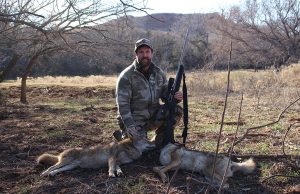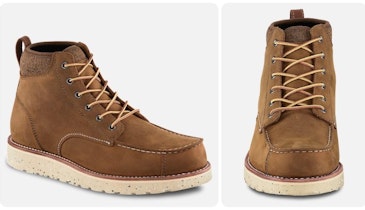A top-notch government trapper once told me not every magpie has a coyote, but every coyote has a magpie. So when a magpie landed in the top of a snowberry bush at the edge of a dense thicket 100 yards in front of me a couple minutes after I started screaming and squalling on my Thompson predator call, I got ready for action.
A minute later, I had a pair of coyotes — No. 5 and 6 for the day — and my guide was smiling from ear to ear. The coyote pelts were beautiful, prime, pale, heavily furred with snow-white bellies, which is typical of Alberta, Canada.
My choice of the top out-of-state predator hunting area would depend on two major factors: quality and quantity.
For a late-fall, early-winter predator hunting foray when fur quality was of prime importance, my first choice for an out-of-state hunt (and, in this case, an out-of-country predator hunt) would be the Canadian prairie province of Alberta.
Alberta, Canada
Alberta has some of the largest, best-looking coyotes I have hunted — and lots of them. In addition, Alberta has a stable population of very large wolves that can be hunted in conjunction with a coyote hunt.
A licensed outfitter or hunter host is required for hunting coyotes and wolves by a non-resident alien (that’s you and me). There are many outfitters and guides in Alberta that host predator hunters at reasonable rates and a quick internet search will locate one of your choice.
Texas
If you’re strictly interested in lots of action in the form of coyotes with a good opportunity to add gray fox and bobcats to the target list, my choice would have to be the Lone Star state — Texas. The whole state has a burgeoning population of coyotes, fox and cats. However, as with all good things, Texas has a few drawbacks. The state is mostly private land with some humongous ranches.
Almost all the private lands, especially in the peak predator areas of southern Texas, have deer management programs that are leased by deer hunters or guide deer hunters on the property. As such, they aren’t interested in allowing predator hunters access during the deer season, which ends in January thus limiting predator hunter access until late winter.
However, many ranches allow predator hunting after the deer season and some even provide lodging and guide service for a nominal fee to predator hunters. The second downside of Texas predator hunting is the quality of pelts is poor. I’ve shot late-season cats when the fur is so thin it looks like the rosettes have been drawn on the skin with a magic marker. However, if you are interested mainly in lots of action and warm weather, Texas is the place to go.
Northern Prairie States
The northern prairie states of North and South Dakota, Montana and Wyoming are also prime states for late-fall and winter predator hunting. That area has high populations of coyotes and red fox and reasonable regulations and license fees.
These states all produce high-quality predator pelts. Despite the last couple years including low fur prices the predator populations are definitely on the upswing and many landowners in these states welcome predator hunters after the closure of the big-game seasons.
Arizona
Aside from Texas, as a late-season predator hunting destination where numbers count more than quality of fur, I would head for Arizona.
This state outlawed trapping on public lands a number of years ago, hence the high predator population of coyotes, gray fox and bobcats. The entire state produces excellent hunting opportunity with very reasonable license fees and regulations along with typically great winter-weather conditions.
New Mexico
Southern New Mexico is just shade behind Arizona in predator hunting opportunity, especially in the southern counties where the ranches are more extensive and the predator populations higher. Nevada also has some superb predator hunting and no license is required — unless you plan on selling the furs, which requires a trapping license.
If you’re thinking of hunting in Nevada, one drawback is non-residents hunters can’t take bobcats or gray fox. Bummer!
An out-of state predator hunt is a great way to beat the winter doldrums. Almost all good predator hunting states can be researched online and most have outfitters and guides that specialize in predator hunting. Check all pertinent regulations in the area of your choice, and take plenty of ammo.
More top picks from Predator Xtreme:
How to scout in summer for coyotes
3 tips to hunt coyotes the simplest way possible
Coyote 101: Understanding how songdogs rear pups
Wild hogs: A must-hunt species







